Exploring the Dual Potential of Artificial Intelligence-Generated Content in the Esthetic Reproduction and Sustainable Innovative Design of Ming-Style Furniture
Abstract
1. Introduction
- Q1: What are the core features of Ming-style furniture esthetics, and how can AIGC technology be applied to reproduce these features accurately?
- Q2: How does AIGC technology help designers to inherit and promote the traditional esthetics of Ming-style furniture in modern furniture design?
- Q3: How does AIGC technology promote innovation in furniture design methods and guide furniture design towards a more environmentally friendly and sustainable future?
2. Literature Review
2.1. Overview of AIGC Technology
2.2. Research on the Esthetics of Ming-Style Furniture
2.3. Research on Sustainable Design Theory
3. Research Design and Methods
3.1. Research Framework Design
3.2. Research Methods
4. Specific Experimental Process
4.1. Construction of a Theoretical Model of Multi-Dimensional Esthetic Elements of Ming-Style Furniture Based on Grounded Theory
4.1.1. Determination of the Research Object—Ming-Style Table Furniture
4.1.2. Grounded Theory Research Process Design
- Data collection and organization;
- Data analysis (including a three-level coding process);
- Construction and optimization of theoretical models;
- Integration of the Ming-style furniture esthetic element library.
4.1.3. Specific Research Process
4.2. Creation of an Exclusive Toolkit for Ming-Style Furniture AIGC
4.2.1. Experimental Design of Language Package for Esthetic Characteristics of Ming-Style Furniture
4.2.2. Development of Exclusive Prompts Formula Cards for Ming-Style Furniture on the Midjourney Platform
- /imagine prompt: Subject + Subcategories + Shape Characteristics + Decoration Features + Material Features + Background + Product Perspective.
4.2.3. Usability Test of AIGC Exclusive Tool Kit for Ming-Style Furniture
4.3. Integrating Sustainable Design Theory and Developing Innovative Design Methods for New Chinese-Style Furniture
4.3.1. Importance of Sustainability and Design Principles
- Reduce: this principle prioritizes raw materials and energy consumption during manufacturing processes to alleviate environmental impacts and decrease waste production.
- Re-use: this principle encourages the maximal re-use of products or their components before the end of their lifecycle, thereby minimizing waste.
- Recycle: when products cannot be re-used, adherence to the recycling principle ensures materials’ effective recovery and re-use, promoting resource circularity.
- Recovery: beyond material recycling, it is crucial to recover energy from waste products or production processes to enhance energy efficiency.
- Repair: designs should facilitate easy repair, allowing timely repairs that prolong the lifespan of the product.
- Refuse: to safeguard environmental and human health, the design phase should reject the use of environmentally harmful or unsustainable materials and processes.
- Re-design: this principle emphasizes the importance advocating for integrating environmental sustainability considerations throughout the product design and development stages. This integration is believed to facilitate the fulfilment of sustainable development goals.
4.3.2. Sustainable Innovation Design Process of New Chinese-Style Furniture
5. Results and Discussion
6. Conclusions
Author Contributions
Funding
Institutional Review Board Statement
Informed Consent Statement
Data Availability Statement
Acknowledgments
Conflicts of Interest
References
- Fui-Hoon Nah, F.; Zheng, R.; Cai, J.; Siau, K.; Chen, L. Generative AI and ChatGPT: Applications, challenges, and AI-human collaboration. J. Inf. Technol. Case Appl. Res. 2023, 25, 277–304. [Google Scholar] [CrossRef]
- Zhang, C.; Zhang, C.; Zheng, S.; Qiao, Y.; Li, C.; Zhang, M.; Dam, S.K.; Thwal, C.M.; Tun, Y.L.; Huy, L.L.; et al. A complete survey on generative ai (aigc): Is chatgpt from gpt-4 to gpt-5 all you need? arXiv 2023, arXiv:2303.11717. [Google Scholar]
- Liu, Z.; Li, Y.; Cao, Q.; Chen, J.; Yang, T.; Wu, Z.; Hale, J.; Gibbs, J.; Rasheed, K.; Liu, N.; et al. Transformation vs tradition: Artificial general intelligence (agi) for arts and humanities. arXiv 2023, arXiv:2310.19626. [Google Scholar]
- Quan, H.; Li, S.; Zeng, C.; Wei, H.; Hu, J. Big data and AI-driven product design: A survey. Appl. Sci. 2023, 13, 9433. [Google Scholar] [CrossRef]
- Guan, N. The inheritance and innovation of Chinese creation culture. Theor. Res. Lit. Art 2019, 39, 1–12. [Google Scholar]
- Huang, W.; Zhang, M.; Wu, J. The influence of literati design in the Ming Dynasty on the formation of Ming style furniture style. Packag. Eng. 2015, 36, 80–84. [Google Scholar]
- Fan, K.K.; Feng, T.T. Discussion on sustainable development strategies of the traditional handicraft industry based on su-style furniture in the ming dynasty. Sustainability 2019, 11, 2008. [Google Scholar] [CrossRef]
- Yan, C. Research on new Chinese-style furniture design based on the characteristics of Ming-style furniture. Furnit. Inter. Decor. 2022, 29, 81–85. [Google Scholar]
- Dangelico, R.M.; Pujari, D. Mainstreaming green product innovation: Why and how companies integrate environmental sustainability. J. Bus. Ethics 2010, 95, 471–486. [Google Scholar] [CrossRef]
- Jiang, S.; Hu, J.; Wood, K.L.; Luo, J. Data-driven design-by-analogy: State-of-the-art and future directions. J. Mech. Des. 2022, 144, 020801. [Google Scholar] [CrossRef]
- Verganti, R.; Vendraminelli, L.; Iansiti, M. Innovation and design in the age of artificial intelligence. J. Prod. Innov. Manag. 2020, 37, 212–227. [Google Scholar] [CrossRef]
- Cao, Y.; Li, S.; Liu, Y.; Yan, Z.; Dai, Y.; Yu, P.S.; Sun, L. A comprehensive survey of ai-generated content (aigc): A history of generative ai from gan to chatgpt. arXiv 2023, arXiv:2303.04226. [Google Scholar]
- Anantrasirichai, N.; Bull, D. Artificial intelligence in the creative industries: A review. Artif. Intell. Rev. 2022, 55, 589–656. [Google Scholar] [CrossRef]
- Xu, J.; Zhang, X.; Li, H.; Yoo, C.; Pan, Y. Is everyone an artist? A study on user experience of AI-based painting system. Appl. Sci. 2023, 13, 6496. [Google Scholar] [CrossRef]
- Wu, F.; Hsiao, S.W.; Lu, P. An AIGC-empowered methodology to product color matching design. Displays 2024, 81, 102623. [Google Scholar] [CrossRef]
- Jaruga-Rozdolska, A. Artificial intelligence as part of future practices in the architect’s work: MidJourney generative tool as part of a process of creating an architectural form. Architectu 2022, 3, 71. [Google Scholar] [CrossRef]
- Yang, Q.; Steinfeld, A.; Rosé, C.; Zimmerman, J. Re-examining whether, why, and how human-AI interaction is uniquely difficult to design. In Proceedings of the 2020 CHI Conference on Human Factors in Computing Systems, Honolulu, HI, USA, 25–30 April 2020; pp. 1–13. [Google Scholar]
- Wang, T.; Zhang, Y.; Qi, S.; Zhao, R.; Xia, Z.; Weng, J. Security and privacy on generative data in aigc: A survey. arXiv 2023, arXiv:2309.09435. [Google Scholar]
- Zhang, D. Traditional characteristics of Ming-style furniture. For. Prod. Ind. 1999, 13–17. [Google Scholar] [CrossRef]
- Sun, C.; Zheng, Q. Exploring the aesthetic characteristics of Ming-style furniture. Furnit. Inter. Decor. 2021, 9–11. [Google Scholar] [CrossRef]
- Yu, K. Exploration and research on the modern translation of traditional Chinese Ming-style furniture. Packag. Eng. 2020, 41, 150–161. [Google Scholar]
- Chen, Y. The design form of Ming-style furniture and the aesthetic pursuit of simplicity and simplicity—Comment on “Tiangongwenqi: A brief introduction to the beauty of Ming-style furniture”. J. Trop. Crops 2021, 42, 3703. [Google Scholar]
- Zhao, C.; Zhao, X.; Yang, B. A preliminary study on the application of Ming-style furniture elements in modern furniture design. For. Prod. Ind. 2022, 59, 55–59. [Google Scholar]
- Margolin, V. Design for a sustainable world. Des. Issues 1998, 14, 83–92. [Google Scholar] [CrossRef]
- Ljungberg, L.Y. Materials selection and design for development of sustainable products. Mater. Des. 2007, 28, 466–479. [Google Scholar] [CrossRef]
- Sujova, A.; Marcinekova, K.; Hittmar, S. Sustainable optimization of manufacturing process effectiveness in furniture production. Sustainability 2017, 9, 923. [Google Scholar] [CrossRef]
- Yang, D. Design for Environmentally Sustainable Furniture Systems—The Knowledge and Know-How of Furniture Life Cycle Design and Furniture Sustainable Product-Service System Design; Routledge: London, UK, 2023. [Google Scholar]
- Rugman, A.M.; D’cruz, J.R. The” double diamond” model of international competitiveness: The Canadian experience. MIR Manag. Int. Rev. 1993, 33, 17–39. [Google Scholar]
- Glaser, B.G.; Strauss, A.L.; Strutzel, E. The Discovery of Grounded Theory; Strategies for Qualitative Research. Nurs. Res. 1968, 17, 364. [Google Scholar] [CrossRef]
- Corbin, J.; Strauss, A. Basics of Qualitative Research: Techniques and Procedures for Developing Grounded Theory; Sage Publications: Thousand Oaks, CA, USA, 2014. [Google Scholar]
- Vollstedt, M.; Rezat, S. An introduction to grounded theory with a special focus on axial coding and the coding paradigm. Compend. Early Career Res. Math. Educ. 2019, 13, 81–100. [Google Scholar]
- Hallberg, L.R.M. The “core category” of grounded theory: Making constant comparisons. Int. J. Qual. Stud. Health Well-Being 2006, 1, 141–148. [Google Scholar] [CrossRef]
- Su, N. Positivist qualitative methods. In The Sage Handbook of Qualitative Business and Management Research Methods; Cassell, C., Cunliffe, A.L., Grandy, G., Eds.; SAGE Publications Ltd.: London, UK,, 2017; 624p, Available online: http://digital.casalini.it/9781526430182 (accessed on 28 April 2024).
- Narbaev, T.; Amirbekova, D. Research productivity in emerging economies: Empirical evidence from Kazakhstan. Publications 2021, 9, 51. [Google Scholar] [CrossRef]
- Yanow, D.; Schwartz-Shea, P. Interpretation and Method: Empirical Research Methods and the Interpretive Turn; Routledge: London, UK, 2015. [Google Scholar]
- Fetters, M.D.; Molina-Azorin, J.F. The journal of mixed methods research starts a new decade: The mixed methods research integration trilogy and its dimensions. J. Mix. Methods Res. 2017, 11, 291–307. [Google Scholar] [CrossRef]
- Jacquemin, L.; Pontalier, P.Y.; Sablayrolles, C. Life cycle assessment (LCA) applied to the process industry: A review. Int. J. Life Cycle Assess. 2012, 17, 1028–1041. [Google Scholar] [CrossRef]
- Clarke, A. Evaluation research: An introduction to principles, methods and practice. In Evaluation Research; Sage: London, UK, 1999; pp. 1–224. Available online: http://digital.casalini.it/9781446202203 (accessed on 28 April 2024).
- Wang, Y.; Gan, Y.; Liu, X. Extraction of Ming-style furniture styling combination rules based on grounded theory. Packag. Eng. 2023, 44, 268–279. [Google Scholar]
- Tan, L.; Xia, L.; Deng, W. Research on the form of Ming-style table furniture based on analysis of structural component characteristics. Furnit. Inter. Decor. 2017, 106–108. [Google Scholar]
- Borger, J.G.; Ng, A.P.; Anderton, H.; Ashdown, G.W.; Auld, M.; Blewitt, M.E.; Brown, D.V.; Call, M.J.; Collins, P.; Freytag, S.; et al. Artificial intelligence takes center stage: Exploring the capabilities and implications of ChatGPT and other AI-assisted technologies in scientific research and education. Immunol. Cell Biol. 2023, 101, 923–935. [Google Scholar] [CrossRef] [PubMed]
- Chiu T K, F. The impact of Generative AI (GenAI) on practices, policies and research direction in education: A case of ChatGPT and Midjourney. Interact. Learn. Environ. 2023, 1–17. [Google Scholar] [CrossRef]
- Yin, H.; Zhang, Z.; Liu, Y. The Exploration of Integrating the Midjourney Artificial Intelligence Generated Content Tool into Design Systems to Direct Designers towards Future-Oriented Innovation. Systems 2023, 11, 566. [Google Scholar] [CrossRef]
- Wang, S. The “Quality” of Ming-style Furniture. Cult Relics 1980, 74–81+105. [Google Scholar]
- Norman, D.A. Design for a Better World: Meaningful, Sustainable, Humanity Centered; MIT Press: Cambridge, MA, USA, 2023. [Google Scholar]
- Setiawan, D.; Hidayat, A.; Supriyadi, S.; Lestari, W. Environmental ethics policy in Jepara: Optimization of handicraft designs from wood waste in the furniture industry. J. Korean Wood Sci. Technol. 2023, 51, 392–409. [Google Scholar] [CrossRef]
- Huang, B.; Wang, X.; Kua, H.; Geng, Y.; Bleischwitz, R.; Ren, J. Construction and demolition waste management in China through the 3R principle. Resour. Conserv. Recycl. 2018, 129, 36–44. [Google Scholar] [CrossRef]
- Jestratijevic, I.; Maystorovich, I.; Vrabič-Brodnjak, U. The 7 Rs sustainable packaging framework: Systematic review of sustainable packaging solutions in the apparel and footwear industry. Sustain. Prod. Consum. 2022, 30, 331–340. [Google Scholar] [CrossRef]
- Hegab, H.; Khanna, N.; Monib, N.; Salem, A. Design for sustainable additive manufacturing: A review. Sustain. Mater. Technol. 2023, 35, e00576. [Google Scholar] [CrossRef]
- Ead, A.S.; Appel, R.; Alex, N.; Ayranci, C.; Carey, J.P. Life cycle analysis for green composites: A review of literature including considerations for local and global agricultural use. J. Eng. Fibers Fabr. 2021, 16, 15589250211026940. [Google Scholar] [CrossRef]
- Bertoni, M. Multi-criteria decision making for sustainability and value assessment in early PSS design. Sustainability 2019, 11, 1952. [Google Scholar] [CrossRef]
- de Aguiar, J.; de Oliveira, L.; da Silva, J.O.; Bond, D.; Scalice, R.K.; Becker, D. A design tool to diagnose product recyclability during product design phase. J. Clean. Prod. 2017, 141, 219–229. [Google Scholar] [CrossRef]
- Chen, X.; Despeisse, M.; Johansson, B. Environmental sustainability of digitalization in manufacturing: A review. Sustainability 2020, 12, 10298. [Google Scholar] [CrossRef]
- Javaid, M.; Haleem, A.; Singh, R.P.; Suman, R.; Gonzalez, E.S. Understanding the adoption of Industry 4.0 technologies in improving environmental sustainability. Sustain. Oper. Comput. 2022, 3, 203–217. [Google Scholar] [CrossRef]
- Hosta, M.; Zabkar, V. Antecedents of environmentally and socially responsible sustainable consumer behavior. J. Bus. Ethics 2021, 171, 273–293. [Google Scholar] [CrossRef]
- Homa, D.; Hill, C.; Floyd, A.; Pickrell, G.; Hall, H. Fiber Bragg gratings embedded in 3D printed prototypes. Sci. Adv. Today 2016, 2, 25242. [Google Scholar]
- Salet, T.A.; Ahmed, Z.Y.; Bos, F.P.; Laagland, H.L. Design of a 3D printed concrete bridge by testing. Virtual Phys. Prototyp. 2018, 13, 222–236. [Google Scholar] [CrossRef]
- Ngo, T.D.; Kashani, A.; Imbalzano, G.; Nguyen, K.T.; Hui, D. Additive manufacturing (3D printing): A review of materials, methods, applications and challenges. Compos. Part B Eng. 2018, 143, 172–196. [Google Scholar] [CrossRef]
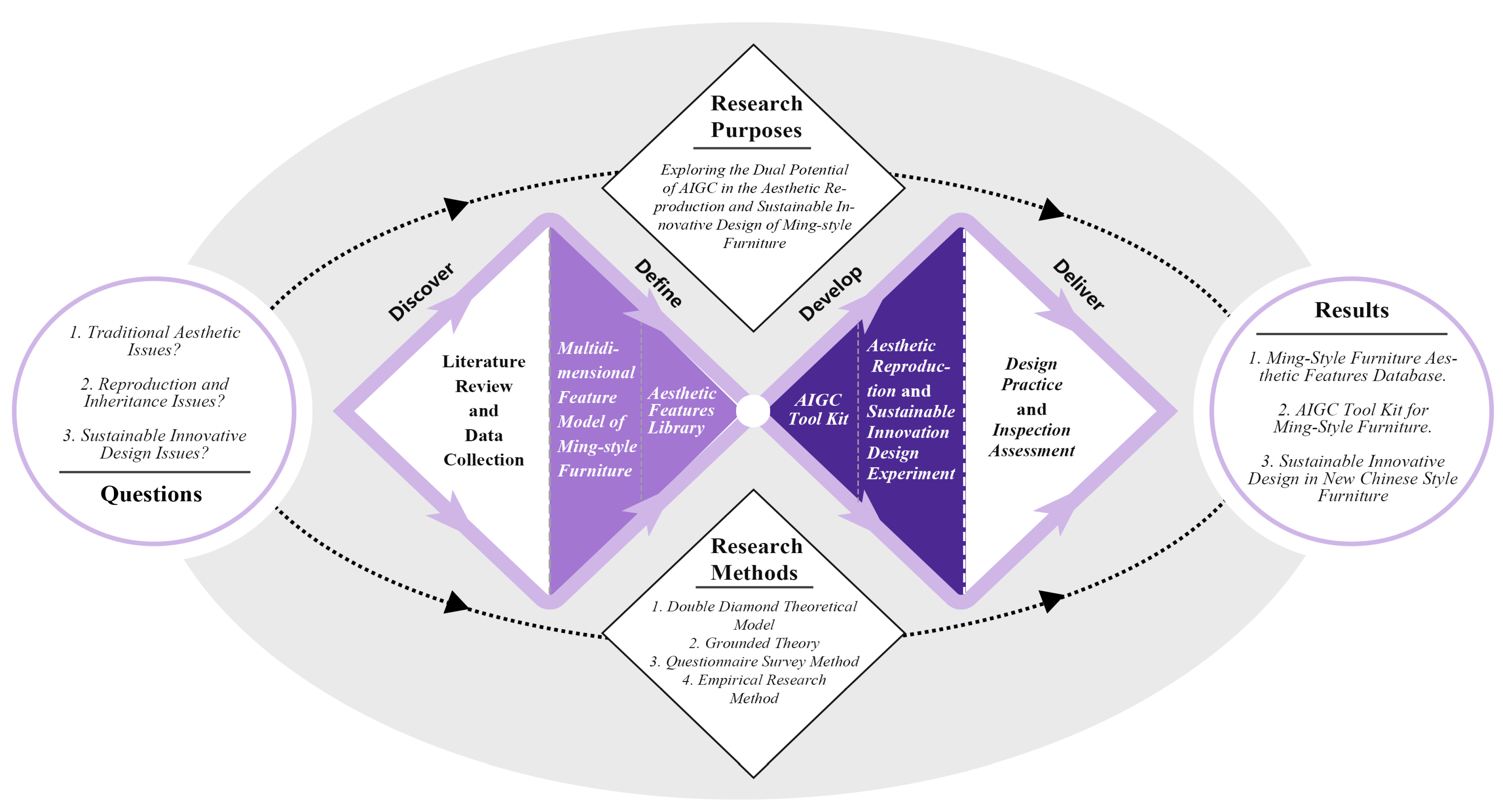

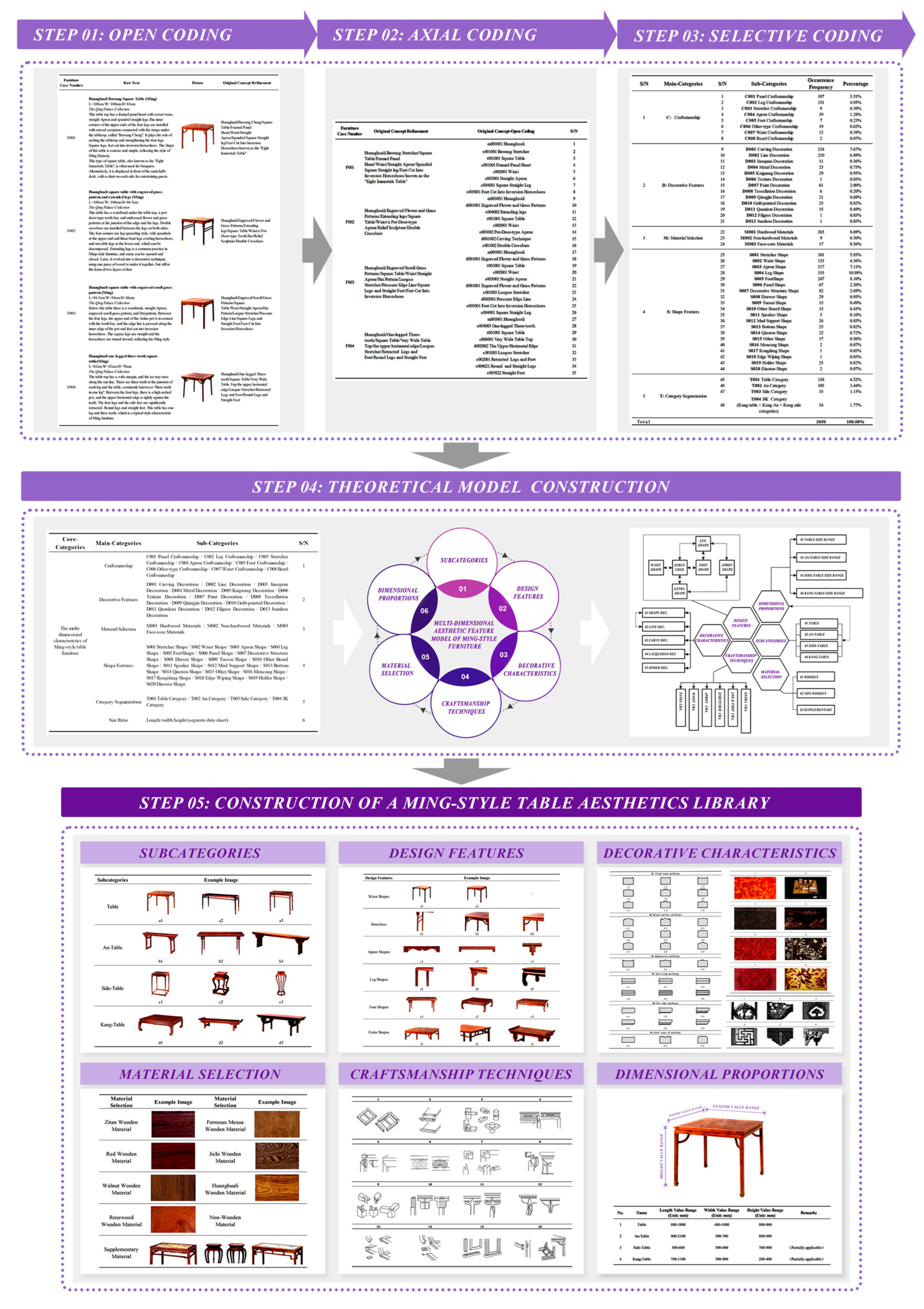
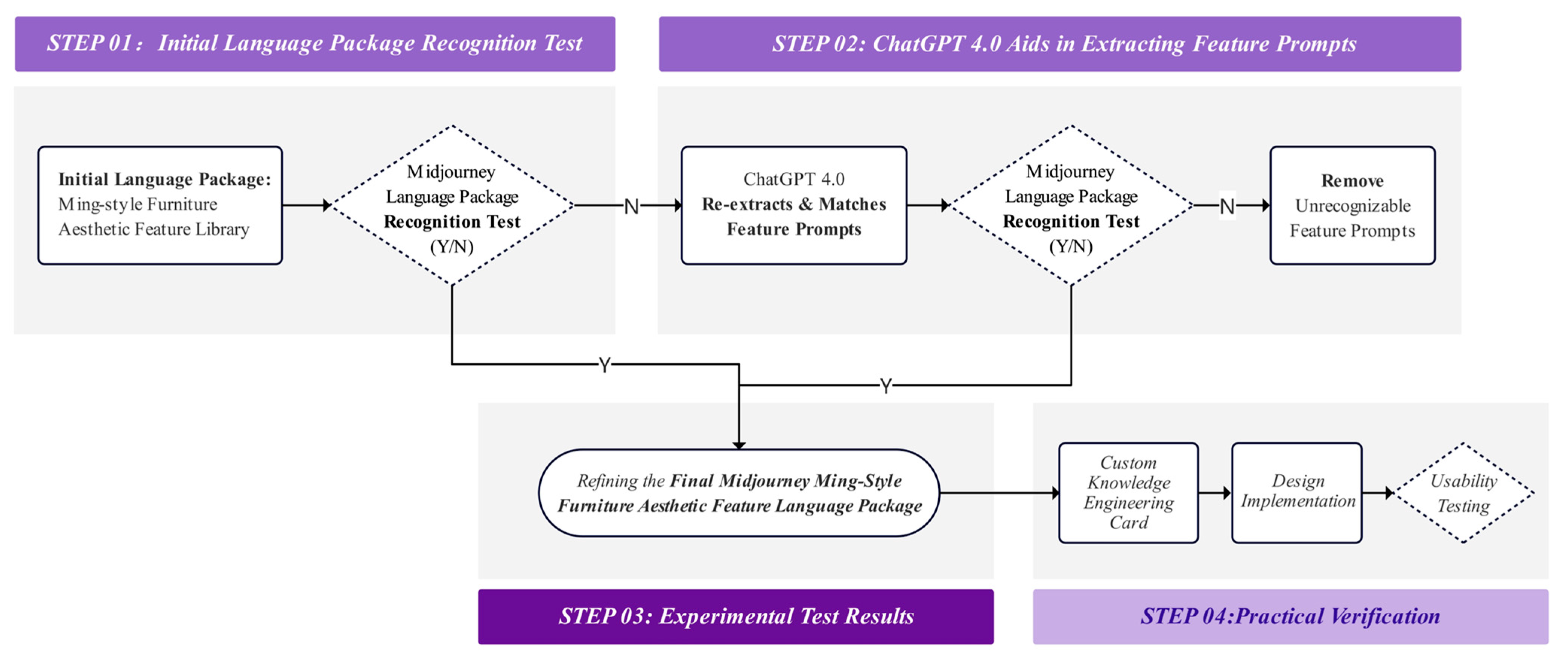
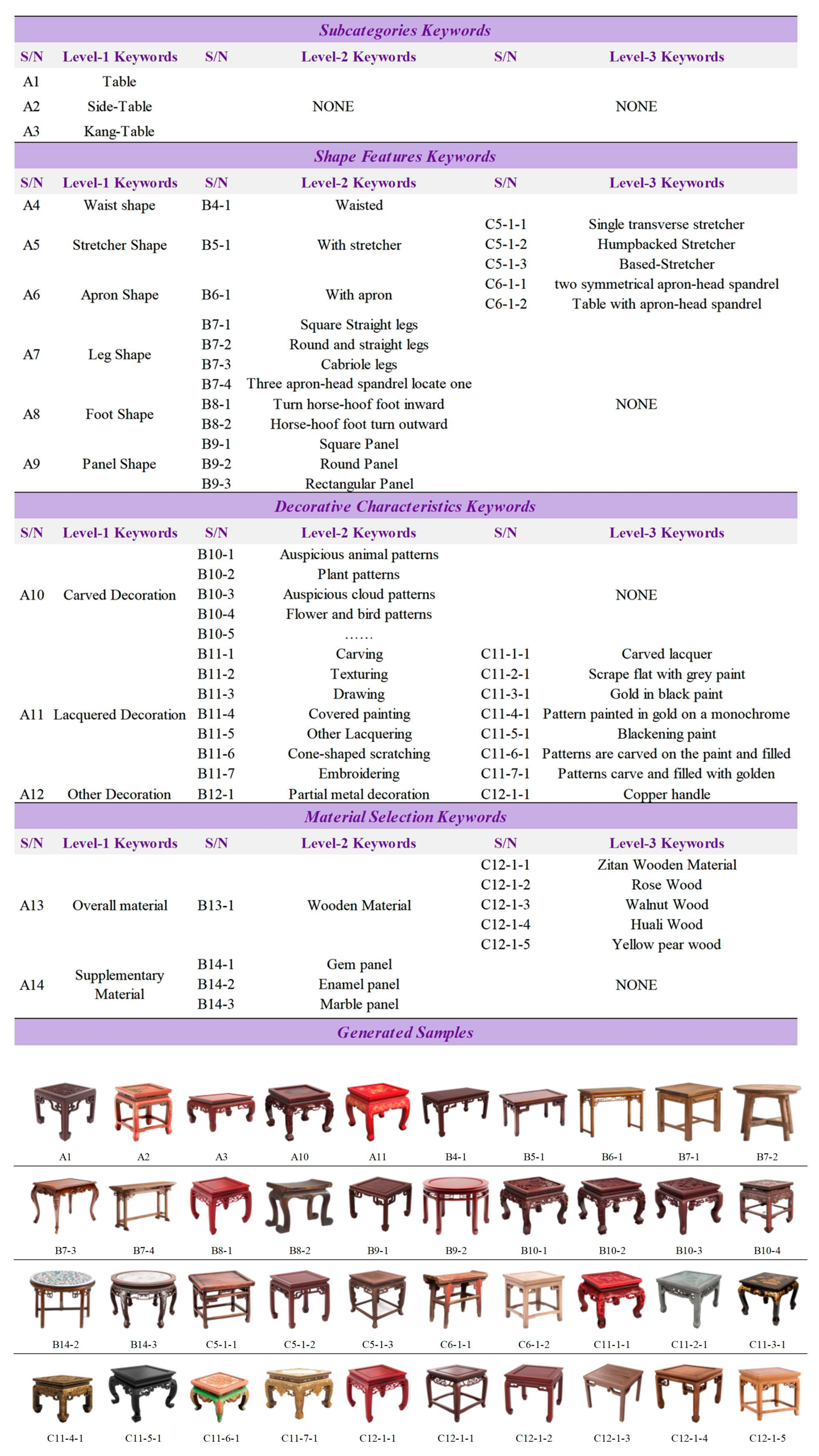
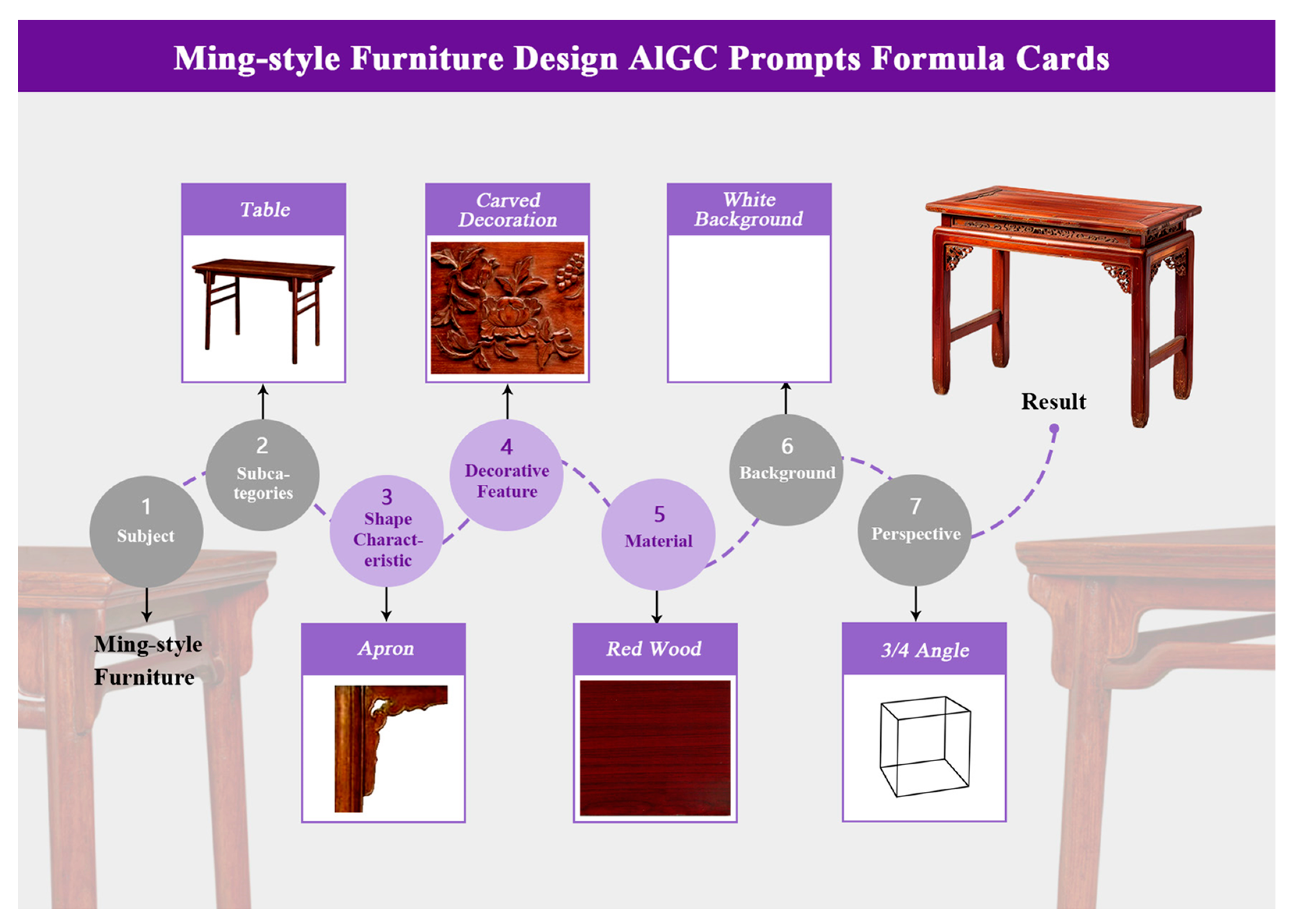
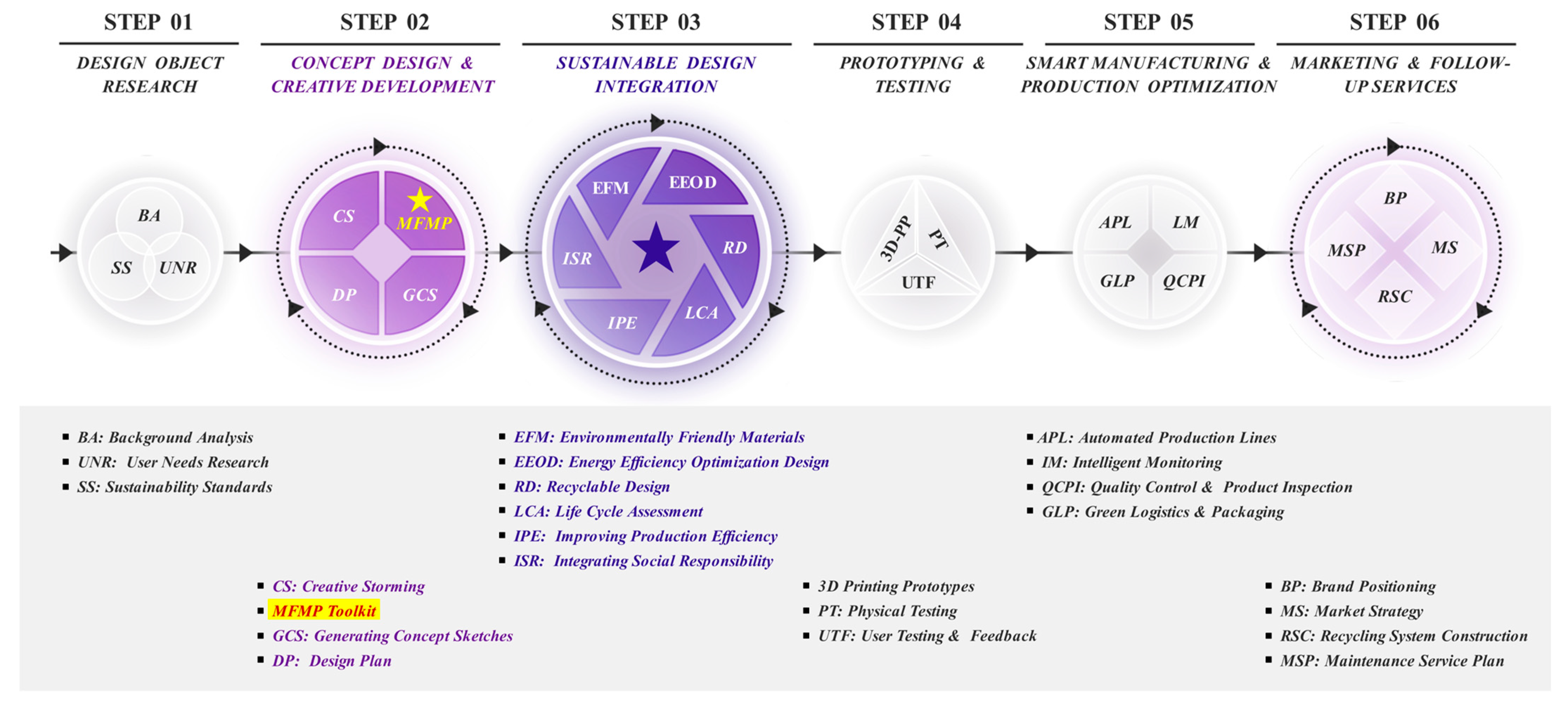
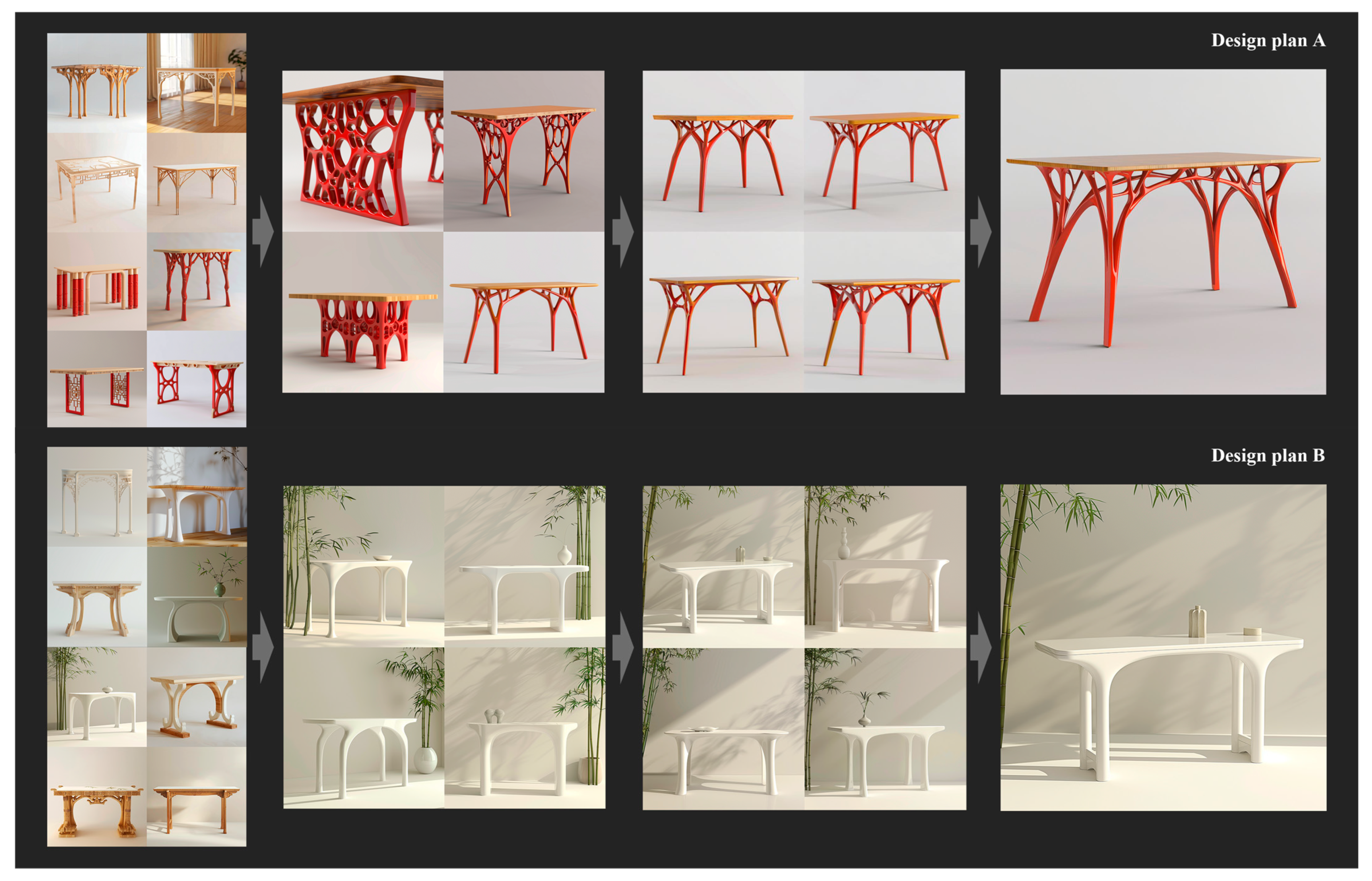
| S/N | Inclusion Criteria | Number of Non-Compliance | Total Number of Non-Compliance | Total Collection |
|---|---|---|---|---|
| Criterion 1: | Closely related to Ming-style furniture and able to find physical books or full-version e-books; | 0 | 11 | 19 |
| Criterion 2: | The book covers the content of Ming-style furniture and table sections, not a simple description; | 6 | ||
| Criterion 3: | The introduction of table furniture in the book includes case picture display; | 1 | ||
| Criterion 4: | The introduction of table furniture in the book contains the text description of the case; | 3 | ||
| Criterion 5: | The introduction of table furniture in the book includes the introduction of the whole body size of most cases; | 0 | ||
| Criterion 6: | Monographs by different authors (to avoid too many duplicate cases). | 1 | ||
| Match Total | 8 |
| S/N | Input Command | Generated Image | Retain/Adjust |
|---|---|---|---|
| 1 | /imagine prompt: Ming Furniture, Table, Square Straight legs, white background, 3/4 angle |  | Retain |
| 2 | /imagine prompt: Ming Furniture, Table, Round straight legs, white background, 3/4 angle |  | Adjust |
| 3 | /imagine prompt: Ming Furniture, Table, Triskelia legs, white background, 3/4 angle |  | Adjust |
| 4 | /imagine prompt: Ming Furniture, Table, Board straight legs, industrial design, white background |  | Adjust |
| 5 | /imagine prompt: Ming Furniture, Table, Three spandrels to one leg, white background, 3/4 angle |  | Adjust |
| 6 | /imagine prompt: Ming Furniture, Table, Convex apron and bulging legs, white background, 3/4 angle |  | Adjust |
| 7 | /imagine prompt: Ming Furniture, Table, Kang-table with extended legs, white background, 3/4 angle |  | Adjust |
| Input Command | Input Image | Answer Output (Focus on Leg Description) | Extract Words | Command Input | Generate Image | Retain/Adjust |
|---|---|---|---|---|---|---|
| Please describe this image from a product designer’s point of view. |  | The table shows sturdy cabriole legs which not only contribute to the overall style but also promise stability. | Cabriole legs | /imagine prompt: Ming Furniture, Table, Cabriole legs, white background, 3/4 angle |  | Retain |
| Number of Items | Sample Size | Cronbach’s Alpha Coefficient |
|---|---|---|
| 16 | 16 | 0.876 |
| No. | Description | Average Score |
|---|---|---|
| 1 | The waist design in the following image matches the Ming-style waist feature | 4.000 |
| 2 | The stretcher design in the following image matches the Ming-style luoguo stretcher feature | 3.938 |
| 3 | The yazi design in the following image matches the Ming-style tooth-like ornamentation | 3.875 |
| 4 | The leg design in the following image matches the Ming-style triple-curved leg feature | 3.750 |
| 5 | The foot design in the following image matches the Ming-style inward-curving horseshoe foot feature | 3.813 |
| 6 | The panel design in the following image matches the Ming-style square ji panel feature | 3.875 |
| 7 | The carving decoration in the following image matches the Ming-style auspicious beast pattern decoration | 3.500 |
| 8 | The lacquer decoration in the following image matches the Ming-style lacquer ash decoration | 3.563 |
| 9 | The material in the following image matches the Ming-style rosewood material feature | 4.000 |
| 10 | The desk type in the following image matches the Ming-style kang desk feature | 3.813 |
| 11 | The yazi structure and carving decoration in the following image matches the Ming-style design and decoration features | 3.875 |
| 12 | The leg design and material in the following image matches the Ming-style round wood straight leg and huanghuali wood feature | 4.000 |
| 13 | The following image’s generated Plan A possesses Ming-style furniture esthetic features | 2.375 |
| 14 | The following image’s generated Plan B possesses Ming-style furniture esthetic features | 3.875 |
| Description | Option | Frequency | Percentage (%) |
|---|---|---|---|
| Which of the following design plans aligns more closely with the sixteen esthetic taste requirements of Ming-style furniture as proposed by Wang Shixiang, a renowned contemporary Chinese expert on Ming-style furniture? | Plan A | 1 | 6.25 |
| Plan B | 15 | 93.75 |
| No. | Description | Average Score of Plan A | Average Score of Plan B |
|---|---|---|---|
| 1 | Correlation between exterior design and design theme “bamboo table” | 3.97 | 2.18 |
| 2 | Correlation between inner artistic conception and design theme “bamboo table” | 2.76 | 2.91 |
| 3 | Correlation between exterior design and design style “new Chinese style” | 3.68 | 2.79 |
| 4 | Correlation between inner artistic conception and design style “new Chinese style” | 2.61 | 3.88 |
| 5 | Creativity of exterior design | 4.26 | 3.36 |
| 6 | Creativity of inner artistic conception | 3.48 | 3.97 |
| 7 | Compliance with basic design requirements | 4.48 | 4.61 |
| Description | Option | Frequency | Percentage (%) |
|---|---|---|---|
| From the perspective of Ming-style furniture research, which design do you think is more in line with the characteristics of Ming-style furniture? | Plan A | 13 | 39.39% |
| Plan B | 20 | 60.61% | |
| From the perspective of contemporary furniture esthetics, which design do you prefer? | Plan A | 10 | 30.30% |
| Plan B | 23 | 69.70% |
| Comparison Dimension | Traditional Furniture Design Model | Innovative Furniture Design Model (This Study) |
|---|---|---|
| Design concept | Mainly based on traditional crafts and manual skills, emphasizing the continuation of history and culture | Combining A1GC technology, integrating traditional esthetics with modern innovative elements |
| Material selection | Mainly using natural materials, such as wood and bamboo, focusing on the natural properties of materials | Prioritizing the use of environmentally friendly, renewable and low-carbon materials, emphasizing the sustainability of materials |
| Design tools | Traditional design tools, such as hand-drawn sketches and hand-made models | AIGC toolkit (MFMP) based on the Midjourney platform to achieve intelligent design |
| Production process | Hand-made and small-scale production, complex and time-consuming | Intelligent manufacturing and automated production to improve production efficiency and reduce energy consumption |
| User participation | Low user participation, designers dominate the design process | User feedback and demand research throughout the design process, emphasizing user-centered design |
| Environmental impact | Great impact on the environment, obvious pollution problems in material consumption and production process | Applying the 7R principle (reduce, re-use, recycle, recovery, repair, refuse, redesign) to minimize environmental impact |
| Life cycle management | Less attention paid to product life and maintainability | Focusing on the full life cycle management of products, including design, use, recycling, and re-use |
| Marketing and service | Relying on traditional channels and word-of-mouth communication, the service system is not sound | Establishing a complete marketing strategy and customer service system, and attaching importance to brand building |
| Innovation and sustainability | Lack of innovation, mainly relying on traditional design inheritance | Emphasis on innovative design and sustainable development, promoting the modernization of new Chinese furniture |
Disclaimer/Publisher’s Note: The statements, opinions and data contained in all publications are solely those of the individual author(s) and contributor(s) and not of MDPI and/or the editor(s). MDPI and/or the editor(s) disclaim responsibility for any injury to people or property resulting from any ideas, methods, instructions or products referred to in the content. |
© 2024 by the authors. Licensee MDPI, Basel, Switzerland. This article is an open access article distributed under the terms and conditions of the Creative Commons Attribution (CC BY) license (https://creativecommons.org/licenses/by/4.0/).
Share and Cite
Wang, Y.; Xi, Y.; Liu, X.; Gan, Y. Exploring the Dual Potential of Artificial Intelligence-Generated Content in the Esthetic Reproduction and Sustainable Innovative Design of Ming-Style Furniture. Sustainability 2024, 16, 5173. https://doi.org/10.3390/su16125173
Wang Y, Xi Y, Liu X, Gan Y. Exploring the Dual Potential of Artificial Intelligence-Generated Content in the Esthetic Reproduction and Sustainable Innovative Design of Ming-Style Furniture. Sustainability. 2024; 16(12):5173. https://doi.org/10.3390/su16125173
Chicago/Turabian StyleWang, Yali, Yuchen Xi, Xinxiong Liu, and Yan Gan. 2024. "Exploring the Dual Potential of Artificial Intelligence-Generated Content in the Esthetic Reproduction and Sustainable Innovative Design of Ming-Style Furniture" Sustainability 16, no. 12: 5173. https://doi.org/10.3390/su16125173
APA StyleWang, Y., Xi, Y., Liu, X., & Gan, Y. (2024). Exploring the Dual Potential of Artificial Intelligence-Generated Content in the Esthetic Reproduction and Sustainable Innovative Design of Ming-Style Furniture. Sustainability, 16(12), 5173. https://doi.org/10.3390/su16125173





